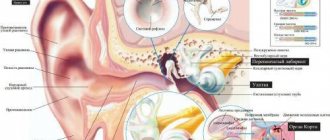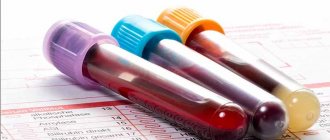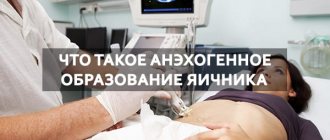Material about a blood test for vitamin D. Everyone knows about the benefits and importance of vitamin D for the body. It is needed for the development of the musculoskeletal system, the strength of bones, teeth and nails, and proper metabolism. It is also known where it comes from: exposure to the sun promotes its synthesis in the body itself, and fatty fish and dairy products replenish reserves from the outside.
How do you know if there is enough of this vitamin, if there is an excess, and what should you do if the balance is upset? The necessary information can be obtained using a special blood test for vitamin D.
Interaction with other elements
Vitamin D (calciferol) has a complex structure, which is similar in structure to a hormone molecule. Therefore, in medical literature it is often called a prohormone.
Vitamin D: 25-OH D2 (25-hydroxyergocalciferol) and 25-OH D3 (25-hydroxycholecalciferol) SEPARATELY at 5 w.d.
from 5710 ₽
Sign up
Vitamin B12 from day 1
from 500 ₽
Sign up
25-OH Vitamin D total (25-hydroxycalciferol) from day 1
from 990 ₽
Sign up
The substance actively interacts with other vitamins, minerals and medications.
Groups of substances and drugs that interact with vitamin D are presented in the table below.
| Effect | Substances |
| Concomitant use is recommended | Phosphorus, calcium, magnesium, vitamin K2, omega-3 fatty acids |
| Neutralizes side effects | B vitamins |
| Impair absorption | Vitamin E in high concentrations, iron, anti-tuberculosis drugs |
| Increased side effects | antacids containing magnesium, cardiac glycosides, thiazide diuretics (hypothiazide, furosemide) |
The remaining substances are neutral to calciferol.
Daily norm of biologically active substance
The body's need for vitamin D depends on many factors. These are age, weight, area of residence, medical history and lifestyle. A greater deficiency in calciferol is observed in the elderly and people living in the northern regions.
To prevent vitamin deficiency, you should consume fish oil. It can be used by children from 4 months. The duration of the course is 2-3 months, then a break. If necessary, repeat use as prescribed by a doctor.
The daily norm of the biologically active substance is 200-600 IU.
Normal vitamin D content in the body
Below are the minimum levels of calciferol that a person requires.
| Age | Quantity per day |
| up to 1 year | 10 mcg |
| 1-70 years | 15 mcg |
| over 71 years old | 20 mcg |
Pregnant and breastfeeding women also need 15 mcg of vitamin D per day.
How to prepare for research
To ensure that laboratory diagnostics are as accurate as possible, follow these simple rules:
- a week before the procedure you need to give up alcohol;
- In 2-3 days you should stop eating fatty foods and fish, sweet drinks.
- At least 8 hours before the test, you should not eat food, drink coffee, tea, or juice. It is acceptable to drink clean still water.
Important: if you are taking medications, notify your doctor about this. Some types of medications may interfere with the test result.
Signs and causes of vitamin D deficiency
A deficiency of a substance usually manifests itself gradually, without pronounced symptoms. The exception is rickets in children. It is important to identify and compensate for calciferol deficiency as early as possible.
Signs of hypovitaminosis D are:
- frequent infectious diseases, purulent complications even with minor injuries, wounds take a long time to heal;
- a feeling of chronic fatigue and weakness, it is impossible to concentrate even on the simplest tasks that previously did not require much effort;
- deterioration of emotional background;
- weakness of bone tissue, fragility or softening due to calcium metabolism disorders, joint and back pain.
- muscle pain - calciferol increases the elasticity of muscle tissue, and aching muscle pain often indicates a deficiency of this substance;
- gaining excess weight.
Of course, all of these signs are not necessarily the result of a lack of vitamin D. They can also appear in other conditions. But during diagnosis, you need to remember about the likelihood of calciferol deficiency. It is advisable to take a blood test for the content of this substance to rule out such a cause.
There are several main factors that cause a lack of vitamin D in the body:
- lack of sun;
- advanced age;
- obesity;
- smoking and alcoholism;
- unbalanced diet;
- chronic diseases;
- hormonal imbalance;
- genetic predisposition.
Vitamin D for children
Since calciferol is responsible for calcium absorption, vitamin deficiency leads to disruption of the formation of bone structures. The bones will thin out, become brittle and brittle, and susceptible to deformation. These changes are the basis of a serious childhood disease - rickets. The discovery of the vitamin at the beginning of the 20th century was a real breakthrough for the treatment of this disease, which has spread enormously throughout the world. Of course, rickets is an extreme degree of deficiency of D2 and D3 in the body. But even with a slight imbalance, certain symptoms in a child will indicate vitamin D hypovitaminosis. What you should pay attention to:
- increased fatigue, moodiness;
- constant anxiety (inability to sit in one place, reaction to sudden sounds and flashes of light);
- poor concentration;
- superficial, light sleep;
- increased sweating (and itching in the head and neck area).
Childhood and adolescence are a time when you should pay special attention to whether your child has enough vitamin D. During these periods of life, this is especially important due to active growth, the formation of all systems and at the same time the child’s continuous learning process. A separate line includes additional clubs and sections so beloved by parents. They create an overload on the child’s body, which means that the child will need to receive a full range of vitamins and mineral supplements.
Consequences of a lack of vitamin D in the body
Hypovitaminosis D leads to aggravation of many chronic diseases:
- diabetes mellitus type 1 and 2;
- migraines;
- atherosclerosis;
- arrhythmias;
- arterial hypertension;
- depression;
- senile dementia;
- Alzheimer's disease;
- autism spectrum disorders;
- psoriasis, eczema and other skin diseases;
- Crohn's disease;
- periodontal disease;
- bronchial asthma, etc.
Another serious consequence of a lack of this substance in infancy is rickets.
Shortage
D3 deficiency is observed in 75% of the world's population, with the majority being children and women. The main causes of hypovitaminosis:
- protein and mono-diets, vegetarianism, improperly organized nutrition;
- pregnancy and breastfeeding (vitamin consumption increases several times);
- mature age, postmenopause;
- for residents of low-sunny areas - lack of sun, long winter-spring period;
- lack of physical activity;
- the presence of kidney and liver pathologies, diseases of the gastrointestinal tract (digestion decreases);
- excess weight;
- hormonal imbalances;
- taking anticholesterol drugs - statins and taking antacids.
The consequences of hypovitaminosis D3 can be the most disastrous. There is a violation of the immune response and metabolism. The pancreas and thyroid gland suffer, disruptions occur in the functioning of the gastrointestinal tract, heart, kidneys and adrenal glands, and lungs.
Corresponding changes appear in the bones due to the leaching of minerals, which ultimately leads to softening of bone structures and osteoporosis. There is weakness and pain in the muscles. During pregnancy, problems with the formation of the fetal skeleton are common (in severe cases).
The menstrual cycle is disrupted, as D deficiency affects the condition of the ovaries. It is possible to develop fibroids and endometriosis due to an imbalance of sex hormones. Characterized by depression, apathy, fatigue, and headaches. The woman becomes anxious and irritable. The condition of hair, skin, and teeth worsens. The incidence of acute respiratory infections is increasing. In advanced situations, arthritis, hypertension, etc. develop.
Signs and causes of excess vitamin D
The main symptoms of hypervitaminosis D:
- pain in joints, stomach and muscles;
- severe weakness;
- headache;
- drowsiness;
- nausea and vomiting;
- thirst;
- convulsions are possible;
- weight loss;
- constipation or diarrhea;
- polyuria;
- arterial hypertension;
- elevated temperature.
Often, an excess of calciferol occurs in children. The reasons are quite simple. Frightened mothers, with good intentions, instead of a few drops, give the drug to the child with spoons.
Forms
Calciferol exists in two main forms - D2 and D3. Activation of both forms occurs in the liver tissue - up to 90% and in the kidneys.
Cholecalciferol, or D3
It is synthesized in epidermal cells under the influence of solar ultraviolet radiation. To meet the nutrient requirement, you should take sunbathing for half an hour 2-3 times a week. Particularly intense synthesis occurs from 11.00 to 14.00, but it is during these hours that our skin needs additional protection. Therefore, it is better to choose a time for “tanning” before eleven o’clock in the morning or after lunch.
In people with dark skin, the formation of the vitamin occurs more slowly. The rate of cholecalciferol production also decreases with age. Synthesis is negatively affected by poor ecology (due to air pollution, the depth of penetration of ultraviolet radiation through the layers of the atmosphere decreases) and sunscreens.
Ergocalciferol
Receipt from outside with food products.
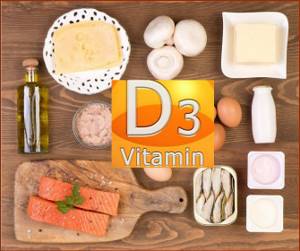
The most valuable in this regard:
- fatty fish;
- egg yolk;
- dairy products - cream, full-fat sour cream, cheeses;
- corn oil;
- seafood;
- meat;
- beef liver;
- yeast.
Ergocalciferol is found in small concentrations in foods of plant origin: some fruits, dandelion greens, oatmeal, alfalfa, nettles, nuts.
To prevent the structure of the substance from being destroyed during cooking, boiling (temperatures above 100 degrees) must be avoided.
It has already been proven that ordinary food is not able to provide us with sufficient amounts of calciferol. In addition, not all food is allowed to be consumed during pregnancy and breastfeeding. Many of these foods contain high levels of cholesterol.
Consequences of excess vitamin D
Consequences of overdose:
- blockage of the bladder and ureters;
- calcification of the lungs, kidneys and heart;
- calcium deposition in blood vessels;
- the occurrence of pancreatitis;
- development of mastitis and lactostasis if hypervitaminosis D appeared during breastfeeding.
An overdose has a negative effect on bones and muscles. Excessive amounts of the substance stiffen connective tissue and lead to brittle bones. This provokes fractures, sprains, dislocations and other injuries.
Hypervitaminosis also causes disruptions in the synthesis of hormones and the production of a number of enzymes necessary for the normal functioning of the body. When nerve fibers calcify, neuroimpulses slow down, coordination of movements worsens, and convulsions and tremors appear.
Main functions
Vitamin D is especially important for women. For ladies, its consumption is much higher than for the stronger sex. This is due to many functions of the female body: the ability to bear and feed a child, the menstrual cycle, menopause and changes in hormonal levels during these conditions. Therefore, depending on the period of life, the need for calciferol can increase sharply. Women need to monitor the adequacy of vitamin D concentration, avoiding its deficiency or excess.
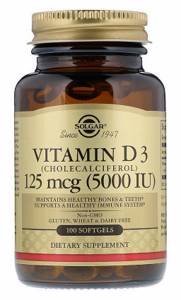
Vitamin D3
Calciferol is necessary because it:
- controls the functioning of many organ systems: endocrine, vascular, nervous, immune;
- regulates carbohydrate metabolism, affecting weight;
- responsible for the work of more than two hundred genes;
- affects the concentrations of calcium and phosphorus in the blood (the condition of bone and muscle tissue, especially teeth, joints, and the formation of posture in childhood depends on this);
- has antitumor and anti-inflammatory activity, exhibits immunomodulatory properties;
- slows down the onset of age-related changes, corrects the condition during menopause and premenstrual syndrome;
- promotes the onset and maintenance of pregnancy;
- participates in the restoration of the body after childbirth and feeding;
- has a beneficial effect on cognitive functions - attention, memory;
- takes part in the restoration of the retina.
Rules for taking vitamin D
Rules for taking pharmaceutical calciferol:
- The drug is taken in the first half of the day (during breakfast or lunch), as it can activate the nervous system. This leads to overexcitation and insomnia. This is especially important to consider when the drug is given to children.
- The substance is a fat-soluble vitamin, so it is advisable to eat something fatty while taking it. This way it is better absorbed by the body.
- Vitamin D and E should be taken separately. When taken together, the absorption of both substances deteriorates.
Treatment
Vitamin deficiency is eliminated by prescribing pharmaceutical drugs, which include vitamin D3 (colecalciferol), Aquadetrim, Vigantol. The dose of one drop is 500 IU (international units). The duration of treatment and dosage depend on the level of vitamin D supply in the body, identified during diagnosis.
After a course of therapy prescribed on an individual basis, tests should be taken. In some cases, lifelong use of the drug is prescribed to maintain the required level of the substance in the body. There is no single scheme; therapy is based solely on examination data.
Patients should not take vitamins uncontrollably - this is just as dangerous as self-prescribing medications. Taking active forms of vitamin D (calcitriol, alfacalcidol) can cause an increase in calcium in the urine to a critical level. If there is a need to prescribe calcitriol, treatment is carried out under the strict supervision of a physician. Therapy is prescribed for extremely low levels of calcium in the blood, with a high risk of developing vitamin D deficiency.
It has been established that an acute toxic condition while taking the drug is caused by doses exceeding 10,000 IU per day. Chronic toxic poisoning occurs at a dosage above 4 thousand IU of the active form per day for three months.
Vitamin D Rich Foods
List of foods high in calciferol:
- Fish. Considered the best source of vitamin D. It is advisable to consume fatty types, such as mackerel, salmon or tuna. Just 100 g of cooked salmon contains almost a daily dose of calciferol.
- Milk and dairy products. They contain not only vitamin D, but also calcium. Cheese and yogurt are especially rich in these substances. But dairy products are often very fatty, so they should be consumed in moderation to avoid gaining excess weight.
- Egg yolks. A medium-sized egg contains approximately 10% of the daily value of calciferol. The highest concentration of the substance is found in the yolk.
- Mushrooms. Mushrooms contain the plant sterol ergosterol. This substance is a precursor to vitamin D. When exposed to sunlight, mushrooms naturally synthesize calciferol.
It is important to remember that taking vitamin complexes with calciferol must be taken according to strict indications. It is unacceptable to exceed the dosage of the drug and other violations of the instructions. An overdose (as well as a deficiency) of vitamin D greatly harms the body. It provokes disruptions in the functioning of the cardiovascular, endocrine and nervous systems.
Complete nutrition and nutritional supplements
We can get many useful substances and vitamins we need from foods. That is why the key to a child’s health is a balanced and proper diet. It must contain proteins, fats, carbohydrates, and fiber. There should be no skew in one direction. The richest in D2 are seafood and fatty fish, and dairy products. Oddly enough, milk itself is not a source of D2 for humans, since calciferol is extremely poorly absorbed from there. The main source of D is believed to be fish oil. Pink salmon, chum salmon, herring, black caviar, cod liver, tuna, egg yolk and even chanterelle mushrooms are also rich in it.
Agree that these are not the products that children love. It will be difficult to feed most children and teenagers with chum salmon or cod liver, but in order to get the right amount of the vitamin, this must be done regularly and in sufficient quantities. What we get from food may not be enough to replenish the daily dose of vitamins in the body as a whole. In addition, the digestibility of minerals and vitamins from any product is quite low: something is lost during the cooking process, something depends on the characteristics of a particular organism - acidity, metabolism, and so on.
In this case, vitamin food supplements come to the rescue. Their undoubted advantage is that they are already calculated taking into account the optimal daily dose and most often combine several well-combined vitamins - they are much easier to take than several vitamins separately. Such complex supplements are an excellent prevention of vitamin deficiency. For example, Amway offers children's jelly lozenges with Omega-3 and vitamin D - they contain up to 80% of the daily value of D2 and D3. After swallowing, the capsule instantly turns into an emulsion, which is best absorbed in the body. And what’s especially nice for children is that there is no fishy aftertaste left after taking it. These lozenges can be given to children from 3 years of age.
Another “delicious” option is Nutrilite lozenges with calcium, magnesium and vitamin D. They will be an excellent help for a growing child’s body. D3 and magnesium will enhance the absorption of calcium, which is responsible for the condition of our bone tissue, teeth, hair and nails. It is fundamentally important to support the musculoskeletal system at the time of rapid growth.
So, the ideal solution to the problem is to eat healthy and varied and add vitamins and minerals in a complex form. They can be taken in courses, and your doctor will help you choose the optimal drug, taking into account the individual characteristics and needs of the child.
Consequences of overdosing
Although the answer to the question of whether vitamin D can be taken by pregnant women is definitely positive, according to current legislation, it is prohibited to prescribe a large dosage of the drug for more than six months without monitoring 25-OH. The reason is the ability of the beneficial substance to be deposited in fatty tissues, which will then lead to an increased level of toxicity. Note that there are no reliable studies on the effects of taking high doses of vitamin D for more than six months.
Most experts believe that vitamin D for pregnant women causes negative consequences only when the dosage is increased at least hundreds of times over six months, which cannot happen under normal conditions.
According to current Russian legislation, there are restrictions on vitamin D during pregnancy if the dose exceeds 600 IU per day. The instructions for use contain a warning about the possible teratogenicity of the drug, although as of 2021, no such cases have been reported.
Vitamin D during pregnancy in the 2nd or 3rd trimester is able to penetrate the placenta and enter the fetus, but the concentration remains very small, tens of times lower compared to the concentration in the blood of a pregnant woman.
Need for large doses
Sometimes vitamin D is required in large doses during pregnancy. According to a report from the World Health Organization:
- Approximately 30% of pregnant women in Europe are deficient in 25-OH vitamin D to the extent that they consume less than 10 ng/ml. At the same time, among representatives of the non-white race, vitamin D 3 is even more deficient during pregnancy, reaching 84% of the total number registered in medical institutions.
- The required level of 25-OH during pregnancy is 30 ng/ml.
- Almost 90% of pregnant women in the world suffer from a deficiency of this useful substance.
The dosage of vitamin D when planning pregnancy is determined based on the fact that when consuming 1,800 IU of the drug every day, it is necessary to spend about two months to transition from a state of deficiency to insufficiency. Considering that the entire pregnancy lasts only 9 months, 2 of which are spent on the initial examination, it is recommended to take care of taking the drug in advance.
The general recommendation of obstetricians and gynecologists is as follows:
“Take vitamin D during pregnancy not from the 3rd trimester, but start from the planning stage of the child. It is necessary to take care in advance about taking useful medications, since during pregnancy the most important resource is time; it cannot be returned.”




